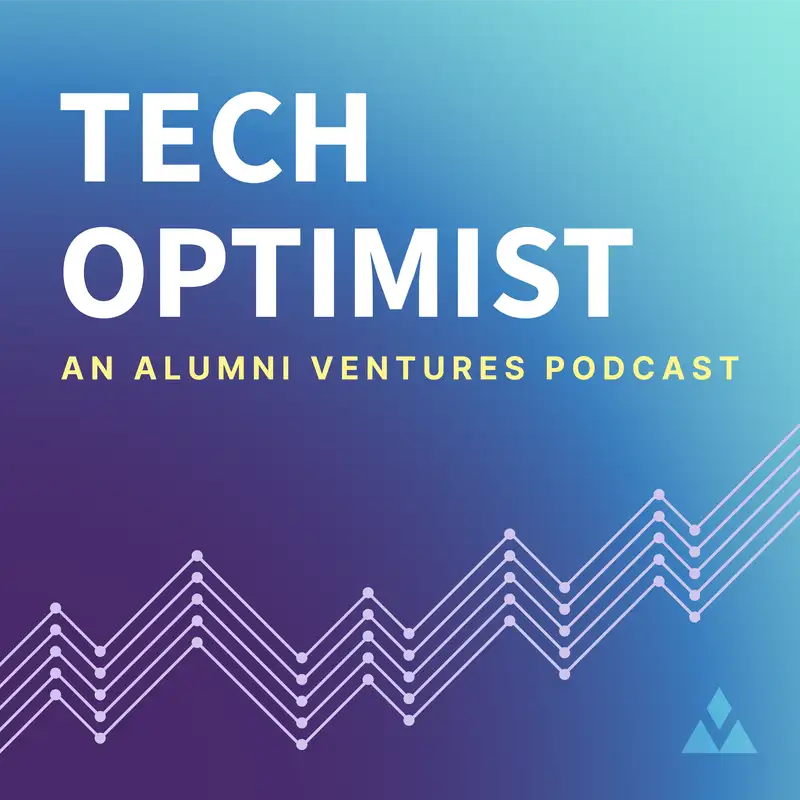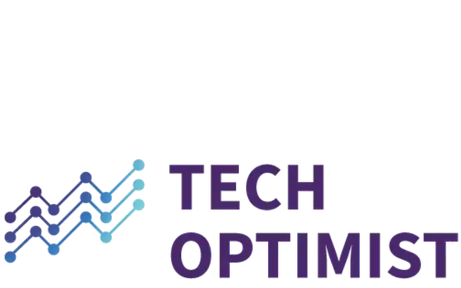#62 - Three Breakthroughs: Warfare Goes High-Tech
Sam:
AI and warfare, 100 open source AI models, and Meta Goggles, let's get into it.
Mike Collins:
The United States has a huge military industrial complex, but the next war is not going to be who has the best battleships and nuclear submarines.
Naren Ramaswamy:
The positive is the accessibility for these models. Everyone will have access to the transformative power of AI.
Mike Collins:
But I think it's like human beings. I mean, we have senses, and I think they're all going to be part of this future, voice, sight, sound.
Sam:
All right, everyone, it's been a second. Welcome back to this episode of The Tech Optimist. We have a Three Breakthroughs episode for you today. Now, we've got a new guest on Mike's other side for this, for these next few episodes, so I'm going to introduce them now. You know him, you love him, Mike Collins, founder and CEO of Alumni Ventures, on one side of the table.
And then not a stranger to the podcast, if you're an OG from day one, Naren Ramaswamy, a principal here at Alumni Ventures, is also on the other side of Mike. And then you know me. My name is Sam. I'm the guide, editor, and narrative savant for this show. I'm going to take you through the show. So a few snippets from the breakthroughs today. I like to leave the breakthroughs kind of like a guessing game for all of you guys listening, so I'm going to try my best not to spoil them this time.
But first, we talk about the changing landscape of warfare and just conflict in nations around the world. And then we also talk about how a company released 100 open source AI models, meaning anyone can get one of these models and train it themselves to do what they want, which is awesome. We get into specifics a little bit later. And then the third breakthrough is Meta and Mark Zuckerberg's latest invention or breakthrough, I guess you could say.
This innovation is crazy. It puts everything that we had thought we knew about reality and virtual reality and augmented reality on its head. So sit back, relax, enjoy this episode of Three Breakthroughs here at The Tech Optimist. We're so happy you're here and we can't wait to share the rest of the show with you. Let's do it.
Audio:
As a reminder, The Tech Optimist Podcast is for the informational purposes only. It is not personalized advice, and it is not an offer to buy or sell securities. For additional important details, please see the text description accompanying this episode.
Mike Collins:
Hello and welcome to this episode of the Tech Optimist Podcast. Calling in remote today, but I'm here with Naren Ramaswamy. And this Three Breakthroughs episode, we created it because our customers want to know what we're thinking about and seeing and we're excited about in the way of technology and breakthroughs. We get together every week and chat about it briefly. Naren, welcome to duty. You've got a month or two in this slot. Congratulations.
Naren Ramaswamy:
Thank you. It's nice to be back in the seat.
Mike Collins:
Great. All right, so yeah, I think I'm going first this week, and I was really struck by the changing face of war. Unfortunately, there's conflict in the world. Statistically, it's been a peaceful time over the course of hundreds of years, but boy, it sure feels not like that when you are following what's going on in Ukraine, Middle, East and elsewhere. But what I think is striking to me is the technology basis of warfare today.
We're seeing things with cybersecurity. The Israeli forces basically blowing up pagers and then really taking out communications. We're seeing in the Ukraine with the Russian War the use of drones. It strikes me as there's disruption going on in the defense industry and there's always the risk of fighting the last war. And it seems that for countries to maintain their military positioning, strategic strength, boy, there are some new vectors one has to be very good at.
Clearly there's the intelligence angle, cybersecurity, cyber hacking, drones, the list goes on and on. Again, I just think we have a Strategic Tech Fund because we're believers in Western democracies being really good at these technologies. But that has really struck home with me this week. Any thoughts on that, Naren?
Naren Ramaswamy:
Absolutely. I think it's always tragic to hear about civilians especially being harmed in the face of war. But the points that you highlighted, I think there's two big opportunities in venture as a result of today's situation. One is around cybersecurity, which is now, what, $250 billion industry largely focused on enterprise cybersecurity. But now if you add departments of defense around the world as a addressable market, it's going to explode in terms of market size.
The second piece is around robotic swarms waging war for you, and we're starting to see companies that are actively pursuing that opportunity. The US Department of Defense has historically been averse to the private sector selling into them, but that's changing now. And frankly, they're realizing that for strategic importance of the country, you have to find the best technology and be armed with it.
And it presents an opportunity for the venture sector and even within Silicon Valley selling to the DOD or the government in general has become more attractive now because of this more friendly environment. So I think it's an exciting time for the Strategic Tech Fund as well as any startups that are even adjacent to selling it to government or defense broadly.
Mike Collins:
Yeah, there's lots to unpack there. One, this was an area that was really I think... There's been a sea change and shift in I think both sides of that equation. The United States has a huge military industrial complex, but the next war is not going to be who has the best battleships and nuclear submarines. And so the ability of entrepreneurs and the US tech industry to provide, I think both sides are way more open to working partnerships right now than really anytime in my lifetime.
I think it's smart. I think it's out of necessity. I think it's obvious that this is where things are going. I think you also raise a really good point that many businesses, this isn't their sole mission, but this is a market that they can take their core product or service and sell into now. So I think that that's an opportunity as well as, as you point out, the adjacencies.
Sam:
Okay, this is a perfect opportunity for me to share one of my favorite content creators to date that I have found. So I'm going to share a video by a video journalist and filmmaker called Johnny Harris. And about eight months ago, he released a video which was titled Why Hacking is the Future of War. Now, the video is incredible. It's written so well.
I'm obviously not going to play the whole video because it's 30 minutes long from what I share, but here's a few snippets from it, which is along the same lines of what Mike and Naren are talking about, the changing face of war and how important and how dangerous and vital cybersecurity and cyber hacking can be. So I hope you enjoy it. We're going to do an ad very, very quickly first. Enjoy this, enjoy Johnny Harris' video, and then we'll get back to the interview. So don't go anywhere, we'll be right back.
Alumni Ventures Ad:
Hey, everyone, just taking a quick break, so I can tell you about the Deep Tech Fund from Alumni Ventures. AV is one of the only VC firms focused on making venture capital accessible to individual investors like you. In fact, AV is one of the most active and best performing VCs in the US, and we co-invest alongside renowned lead investors.
With our Deep Tech Fund, you'll have the opportunity to invest in innovative solutions to major technical and scientific challenges, which can have a hugely positive effect on society. Companies that have the potential to redefine industries and create a more sustainable future and deliver significant financial returns. So if you're interested, visit us at av.vc/funds/deeptech. Now, back to the show.
Johnny Harris:
It's November 10th, 2008. Barack Obama just won an election, and he travels to the White House to meet with the outgoing President George Bush. In that meeting, Bush told Obama about a top secret weapon that the US military had been developing with Israel since 2005, code named Project Olympic Games. This weapon was intended to hit one of Iran's most fortified nuclear facilities, buried deep underground where centrifuges spin uranium to enrich it for use as energy, or with enough spinning, to be used in a nuclear weapon.
But this secret weapon wasn't a missile. They weren't planning an airstrike. Instead, it was a computer file less than a megabyte in size, 150,000 lines of pristine code. This is the weapon that the president had to tell Obama about. This little file had been planted in Iran where it spread throughout the whole country, but it didn't do anything. It laid dormant until it found its way onto a flash drive that was then plugged in at this underground nuclear facility.
And then it spread, finding its way to its final target, this one machine. And then the weapons started working, quietly reprogramming the software to very subtly sabotage these delicate spinning centrifuges, opening a valve to change the pressure, telling the centrifuge to spin a bit faster or a bit slower, all while telling the technicians that everything was working properly.
Over time, these subtle manipulations destroyed these centrifuges. This was one of several weapons that the US had planted in Iran using sophisticated computer code. Now, if a war broke out with Iran, the US could turn off their power, could turn off their military defense systems, making it so they couldn't shoot down planes. They could turn off their command and control systems so they couldn't talk to each other during the fight.
This was a real war plan executed by thousands of American military personnel, hundreds of millions of dollars in a cyber operation that would "prepare the battlefield by weakening Iran's ability to fight." All of it using code. The code that sabotaged the nuclear facility was eventually discovered and named after some of the elements that were inside of these many lines of code, .stub or Mrxnet.
They called it Stuxnet. Now, this weapon did slow down Iran's progress at first, but it didn't stop them. But what this did do was showcase a new style of war, the use of quiet weapons in the form of a tiny text file that could self-replicate and wreak actual physical damage on an enemy. We call this cyber warfare, and it has become a fixture of modern conflict. Let me show you how it works.
Video Audio:
We're moving into a new era. People will actually get killed. Dismantle our communication system. With a click of a button, you can bring down nations to their knees.
Sam:
Okay, that's all the snippet you get. If you want to learn more and you want to watch the rest of that video and the rest of Johnny's incredible portfolio, hop over to his YouTube and go check out the rest of his work. But that's enough snippet for this episode. So enough for me, let's get back to the show.
Mike Collins:
Yeah, I mean, I think on people's minds this week. What else do you got? What's yours?
Naren Ramaswamy:
I think that first topic is a good segue to what I wanted to touch on, which is there was a news article around Alibaba, Chinese Cloud giant, releasing 100 open AI models. Not one or two. These are 100 models, each specific to a different use case or different industry. What's the implication of this in the global AI stage? I think there's two or three implications. One is open AI and companies like OpenAI no longer have competition just in North America.
There's going to be competition from Japan, from, in this case, China, from different countries in Europe, everybody trying to build their own open source models. The positive is the accessibility for these models. Everyone will have access to the transformative power of AI. It's going to be a tool that as long as you have a smartphone or a computer anywhere in the world, you will now not only have access to the world's information through the internet, but being able to derive insights from that information.
And so it's a great equalizer, I think, between the rich and poor. And then the last piece is touching on what we talked about in terms of national interest, you can imagine each of these countries pumping hundreds of millions of dollars towards their own AI models not to be left behind in the global race across different countries. ChatGPT-4 reportedly costs over $100 million to build.
That's a large sum of money for it. We talk about seed rounds in venture. It's $2 million or maybe $4 million. It's also going to change the landscape of venture a little bit, but overall exciting because of the accessibility and the equalizing nature of technology.
Mike Collins:
And Meta also built, release some new open... I think this is a classic. There's open models. I also think it has implications for regulation. Because this is a worldwide open source environment now and that makes great accessibility, that allows innovation to happen anywhere, and it also makes regulation nearly impossible. I mean, the AI LLM model is... That genie is out.
Now you have to look at other things and other parts of the value chain where the chips to run these, the power to support it. We talked a little bit last week about the bottleneck for AI deployment maybe energy, and again, innovators working on that to reduce power consumption. Some of these mini models do much better on that front. But yeah, I mean, this is a global phenomenon. Everybody sees it. Everybody has their own take on it, and everybody's frankly going to have access to it.
Sam:
I'm going to take a few seconds to interject here. CNBC released a really cool article about this phenomenon that Alibaba has maybe started or maybe launched here, and I'm going to read this section of it. So AI models are trained on huge amounts of data. Alibaba says its models have the ability to understand prompts and generate texts and images. Open source means that anyone, including researchers, academics, and companies, around the world can use the models to create their own generative AI apps without needing to train their own systems, saving time and expense.
By open sourcing the models, Alibaba hopes more users will use its AI. The Chinese e-commerce giant first launched its Tongyi Qianwen or Qianwen model last year. Since then, it has released improved versions and says that to date, its open source models have been downloaded 40 million times. The company also said it upgraded its proprietary flagship model called Qwen-Max, which is not open source. Instead, Alibaba sells us capabilities through its cloud computing products to businesses. Pretty cool.
Mike Collins:
I know it's not everybody, but even the new Apple AI, which is just I think more signaling than profound benefits, but clearly anyone with an iPhone is going to have AI access and the features that they are launching. I've been playing with them for a couple of weeks. They're relatively modest, but they work and they add value. And I just think that Apple's going to be a player in this state.
They have the phone. There's a billion of them in people's pockets pretty much all day long. So they're going to be a player as well. But yeah, I think open source. Also, the other thing it does is it also just keeps everybody on their toes. And we've talked about the state of change and improvement. I've spent a lot more time in the last three weeks working with the reasoning models from ChatGPT, and they are a difference maker too.
And I think basically the multi-step process that these beta reasoning models are showing, again, is another game changer. So again, people are like, oh, ChatGPT, then to ChatGPT-4o, and now o1, it's Strawberry, and these reasoning models. It's coming hot and fast.
Naren Ramaswamy:
Just one thing to touch on that is it's fascinating how far open source has come. Two, three decades ago, we were talking about, oh, there's no way. You can't sell something that you've made and offer it for free. How are you going to make money on that? And now it's become table stakes for infrastructure software especially where you build something and why not let somebody else leverage that to build something else?
It's just a virtuous cycle in the whole technology industry that's just going to continue accelerating innovation. And the business model has been proven out. So I think it's a win-win all around.
Mike Collins:
Yeah, no, it's very exciting. The third one, it was a tricky one to pick the third one this week, but I'm going to go back to Meta who had an event and their goggles. And I think Apple with its Vision Pro... When Apple makes a move, everybody pays attention. There hasn't been a lot of talk about it really in the year since they announced. Again, I think there's some hardcore people that are using it, exploring it, but it's not there yet.
And Meta came in with a much smaller form factor, using a combination of hockey puck smaller glasses and something on the wrist, and very impressive. Again, too expensive. I think they're saying that their prototype is $10,000 or so. But for me, again, it's what does that really say? It really says to me that vision is going to be part of the future. And it's not there yet in a mass way, but it is coming. And I think this new framework that...
None of us know how it's all going to play out, but AI coming, is that going to be driven by voice? Again, the new ChatGPT voice stuff, really, really impressive. I know a lot of our people are using it as they drive or commute to interact with things, but I think it's like human beings. I mean, we have senses. And I think there they're all going to be part of this future, voice, sight, sound. I don't know how it's going to play out, and it may be all of the above.
But I think this idea of you've got your phone, you've got your watch, you've got your glasses, you've got your voice. I think to me, I just want to... Let's not lose sight. Augmented reality, virtual reality is something that in our lifetimes is going to just become regular. I mean, I'm traveling a little bit with friends right now, and there's definitely times where it's like people are looking at their phones.
I think that is going to change in the next five years where you're going to be wearing glasses like I'm wearing now and the ability to look something up or somebody goes off and makes dinner reservations. And we're just interacting as human beings. I think it's an important perspective to have, and we all need to be open-minded that I don't think that this story is written yet. For so long, we've been dealing with just...
Since the revolution of the iPhone and the smartphone, so much of our computers has been driven to mobile. And obviously there's still a role for desktop computers, watches, rings, Oura Ring, portfolio company. These different inputs are different makers, but I think AI is going to shake up the deck. It could be all of the above. I don't know. What do you think, Naren?
Sam:
All right. Before we give Naren the mic and let him have his little spiel about these glasses in this breakthrough, I want to provide a bit more information about them, this crazy innovation that Meta has brought to the table. So here are just some details about this prototype. Mike was very clear that this is not finished yet, and Meta has also made it clear that this is not finished yet, that this is a internal device used for research.
So Orion is designed to look and feel like regular glasses, weighing just 98 grams. It offers a 70 degree diagonal field of view, which is notably wide for AR glasses. The current prototype has a resolution of 13 pixels per degree with the goal of reaching 30 in the final product. And Orion uses micro LED projectors that can output hundreds of thousands of nits of brightness, resulting in 300 to 400 nits reaching the user's eyes.
The glasses utilize innovative silicone carbide lenses, which allow for the wide FOV and improved optical clarity. Now, there's a three-part system with the components of the glasses. Orion consists of the glasses, a wireless computing puck, and a neural wristband for control. So this pocket-sized device, the puck, provides wireless AI and AR capabilities with a range of about 12 feet.
The wristband, the device reads electrical signals from wrist movements for subtle socially acceptable input. And users can control Orion through a combination of eye tracking, hand tracking, voice commands, and the neural wristband. So some capabilities and really cool features about it. It's got AI integration, of course, multitasking, so users can perform tasks like viewing recipes, making calls, and browsing social media all at the same time.
There's holographic interactions. So the glasses enable 3D holographic experiences such as playing games, kind of like the Meta Quest headset. And so as far as development and future plan goes, Orion is a functional prototype, like we had talked about earlier, but it plans to produce about a thousand units for testing at an estimated cost at $10,000 per unit. So Mike was really right about this one.
And future plans for these glasses is that Meta sees this as a part of gradual progression towards fully realized AR glasses that could potentially replace smartphones. Think about that for a second. That concept is just absolutely wild and pretty insane. But we're going to wrap up this episode, but we're going to do one more quick add and then we will finish this up. So enjoy.
Alumni Ventures Ad:
Do you have a venture capital portfolio of cutting edge startups? Without one, you could be missing out on enormous value creation and a more diversified personal portfolio. Alumni Ventures, ranked a top 20 VC firm by CB Insights, is the leading VC firm for individual investors. Believe in investing in innovation? Visit av.vc/foundation to get started.
Naren Ramaswamy:
I definitely agree with you. I think all these consumer devices are going to be a medium for these super smart algorithms to just be pervasive around you. There's a lot of pessimism around, oh, AI is going to do everything for you, and what are you going to do? The flip side of it, the optimistic side, is that wouldn't you want a pervasive AI to help you? It's a helper that's going to be around you. You don't have to gaze into the depths of your phone to access it anymore.
You're caring about your day. Maybe you're on the side of the road fixing a tire, you forget what the next step is. You just have to talk to your glasses. It tells you, "Hey, you see that scanner over there? Use that." It's just for the smallest of use cases. You're shopping for groceries. It tells you, "Hey, by the way, this could be bought on Amazon for $3 cheaper. Don't buy it from here."
It's just the smallest of use cases, as well as for doctors that are performing surgery. Across the board, you have this smart, intelligent being that's helping you. So I think that it's going to be a significant chapter in the history of humanity, for sure.
Mike Collins:
Yeah, no. I just want to share one example from one of our teammates who just shared this experience on our AI life lessons channel, where we talk about how we're using these new technologies, big and small. But he was sent to the grocery store by a spouse to buy yogurt, I think, for the kids. And as we all know, there are 4,000 brands, highly differentiated, and a very particular one that he...
So what he did is he basically took a photograph of the entire aisle because he couldn't find it and said, "Where is XYZ brands?" And it literally came back to him and said, "Top row. Third from the end." Now, that was with a phone. You could see we're wearing glasses where it's just literally... He might not even have to audibly say anything. Through the glasses, it might just be pointing an arrow saying, "Buy this one," kind of thing.
I mean, I think these are fun. These are exciting. I think these are going to become fabric of our lives. And we're just starting to see the little pixels coming into view here, but the picture's not complete yet. But boy, it's sure fun trying to see new things coming online. Don't give up on the vision side of it. Again, I'm traveling and brought my Vision Pro.
Because at the office, Naren, as you know, I've got six monitors set up because just things going on and using AI and all that kind of stuff going on. Well, I'm not hauling six monitors to Colorado, but I effectively have it because I can put on my goggles and have my screens where I want them to be and be super duper productive.
Naren Ramaswamy:
Yeah, definitely a game changer.
Mike Collins:
Really exciting. Well, welcome to this segment. I look forward to unpacking a bunch of cool things with you, Naren, over the next couple of months, and we'll talk again next week.
Naren Ramaswamy:
Likewise. Thanks, Mike. Appreciate the opportunity.
Mike Collins:
All right, see you soon. Bye.
Naren Ramaswamy:
See you.
Audio:
Thanks again for tuning into The Tech Optimist. If you enjoyed this episode, we'd really appreciate it if you'd give us a rating on whichever podcast app you're using, and remember to subscribe to keep up with each episode. The Tech Optimist welcomes any questions, comments, or segment suggestions. So please email us at info@techoptimist.vc with any of those and be sure to visit our website at av.vc. As always, keep building.







